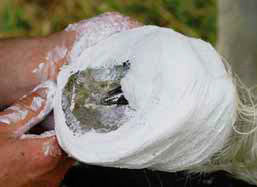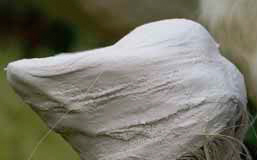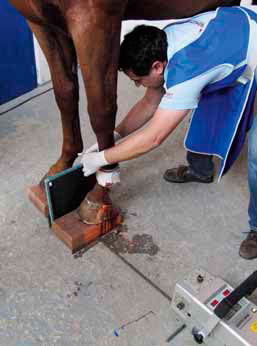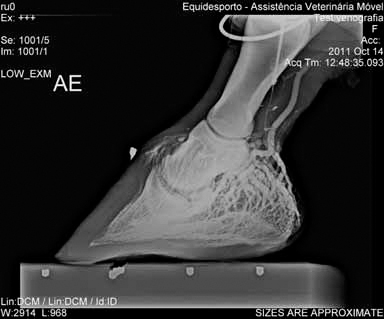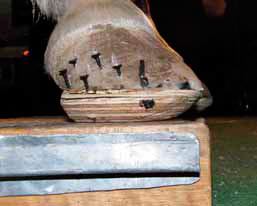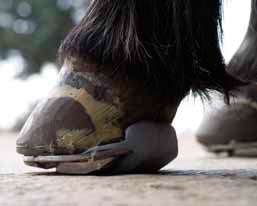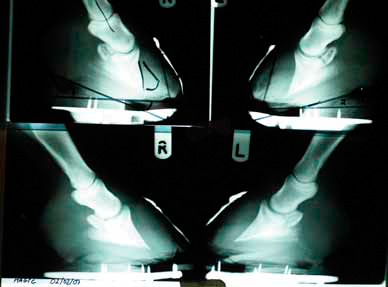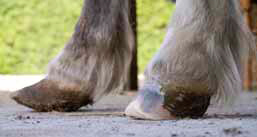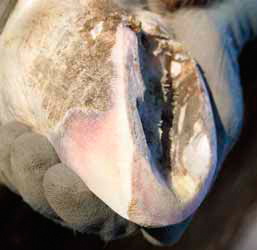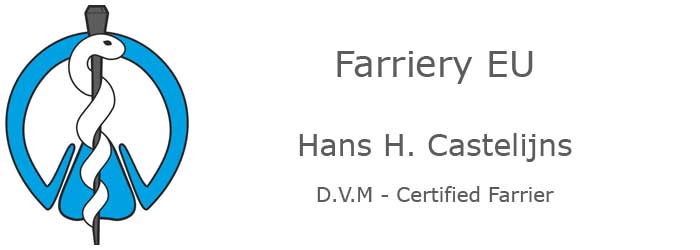
The Laminitic / Foundered horse, from the acute to the chronic case |
||||
1 – Definitions |
||||
Laminitis is the inflammation of the laminar suspensory apparatus of the equine or asinine hoof; founder is the loss of normal relationship between the hoof capsule and the distal phalanx (DP) contained within. Founder can be a consequence of laminitis, but can also occur in the case of extensive onicomycosis (white line disease). In the case of founder there can be: - Capsular rotation - - Sinking - -Phalangeal rotation - - A combination of the above. (Fig. 1) |
||||
|
||||
2 – Acute Laminitis |
||||
Laminitis can be triggered in many different ways and is the second cause of untimely loss of horses according to AAEP data. In the acute phase, the logical first hoof care steps include box rest on deep, soft bedding. The next step is to relieve the laminar suspensory apparatus of the DP by unloading the wall, recruiting the bars and frog into weight bearing, and to diminish the pull of the D.D.F.T. by raising the heels and facilitating dorsal and latero medial break over. This can be achieved with plaster casting, styrofoam pads, silicone imprint material, and specialty boots. Other measures which may be useful / necessary in the acute phase are criotherapy and the use of the Michael Puhl swing lifter. Fig. 2a) 2b) |
||||
|
||||
3 – Sub-acute Laminitis with founder |
||||
In the sub-acute – chronic phase, when at least the initial cause (endometritis, carbohydrate overload, colic, Cushing’s syndrome etc. etc.) has been addressed and laminitis has led to some form of painful founder, each hoof has to be treated individually, with some common principles as a guide: It is indispensable to use x-ray guidance for the trimming and shoeing procedures and it can be useful to use venography. In the authors experience, correct foot radiographs, with the appropriate positioning, focus distance, height and known enlargement factors, are still the exception, making optimal results from the vet – farrier collaboration difficult. Fig.3a) 3b) |
||||
|
||||
The author’s choice of shoeing the painful, subacute cases, which have trouble stabilizing their DPs, is the application, on the trimmed hoof capsule, of a glue on cuff with a screwed on aluminum, closed, full rolling motion shoe and silicone impression material under the frog and bars. This type of shoeing, the biomechanical principles and versatility of which are similar to the use of Steward Clogs, increases sole clearence due to the distal rim of the cuff, permits a considerable leaver arm reduction - thanks to the reduced ground surface of the full rolling motion shoe and its placement under the cuff - and permits accurate application of the silicone imprint material. Relative to the Steward Clog, there is the added advantage of being able to inspect the bottom of the foot and to medicate prolapsed soles on an even daily basis, as the screwed on full rolling motion shoe functions as a hospital plate. On those limbs where the position of the DP within the hoof capsule does not stabilize, which do not improve clinically, or even worsen, and where the phalangeal rotation of the DP keeps increasing, DDFT tenotomy is an appropriate salvage measure. After the tenotomy, the heels should be trimmed for phalangeal alignment and the foot needs a caudal extension to limit the sub-luxation of the DIPJ. Fig.4) - Fig.5) - Fig.6) |
||||
|
||||
|
||||
4 – Chronic founder, past founder |
||||
Horses can go back to more normal shoeing and/or barefoot trims if: - They get enough sole depth under the distal margin of the DP (in the case of tenotomized feet this may mean keeping enough sole depth under the palmar processes). - They have a decent dorsal hoof wall attachment. After a large dorsal hoof wall resection in the case of severe onicomycosis, for example, the dorsal hoof wall should be soundly attached all the way to the distal border of the DP, before shoeing without some kind of frog support. - The ground conditions are good; ideal are dry, soft surfaces. - There is not too much scarring of the (dorsal) laminar suspensory system; (permanently) stretched white lines are easily prey to “gravel” and ascending infections, whether fungal or bacterial in origin. |
||||
5 – Size and breed |
||||
A factor in determining whether a horse or donkey can cope with bare feet, after a severe episode of founder, is size and breed. Small ponies, like Shetlands and small donkeys like Sardinian donkeys, seem to have more “redundancy” built in their hooves, relative to their weight/size. Some breeds, like Haflinger ponies/cobs and P.R.E. horses (“Andalusians”), although often the victim of laminitis/founder, due to their propensity to fatten even on light diets (so called easy keepers), often have strong, fast growing hooves and seem to have a higher capacity to come back from founder. All these type of horses and donkeys need extreme care in their general management, diet and exercise after initial laminitis. On the one hand, they seem to have the capacity to come back and grow normal hooves again, on the other hand, they are also easily victims to new episodes of laminitis if their body condition score is not carefully controlled. The key hoof care in these patients consists in x-ray guided trims, which: - Leave enough (12-15 mm) sole depth below the distal margin of the D.P. - Bring back the, often excessively, long and under run heels to the widest part of the lateral and medial crest of the frog, by trimming the heels from the largest part of the hoof - Realign the dorsal hoof wall, parallel to the dorsal aspect of the DP. - Trim a rocker in the toe area at 30°- 40° to the bottom of the hoof, starting dorsally of the projection of the distal dorsal margin of the DP. - Round of the distal borders of the trimmed hoof. - Treat exposed horny lamellae with hoof hardener and/or disinfectant to present fungal/ bacterial infections. Fig.7a) 7b) |
||||
|
||||
All obese horses, ponies and donkeys which are on a low carb/energy diet, benefit from a good hoof growth supplement, to assure them the microelements for adequate hoof growth. Soft paddocks allow for a better hoof unrollment pattern and therefore more exercise without pain, which together with a strict diet is the best way to a lower body condition score. Older horses and ponies with confirmed Cushing’s syndrome (pituitary pars intermedia dysfunction\adenoma) need to be put on the adequate dose of daily pergolide to keep them from having recurrent bouts of Laminitis. References on request. |
||||

